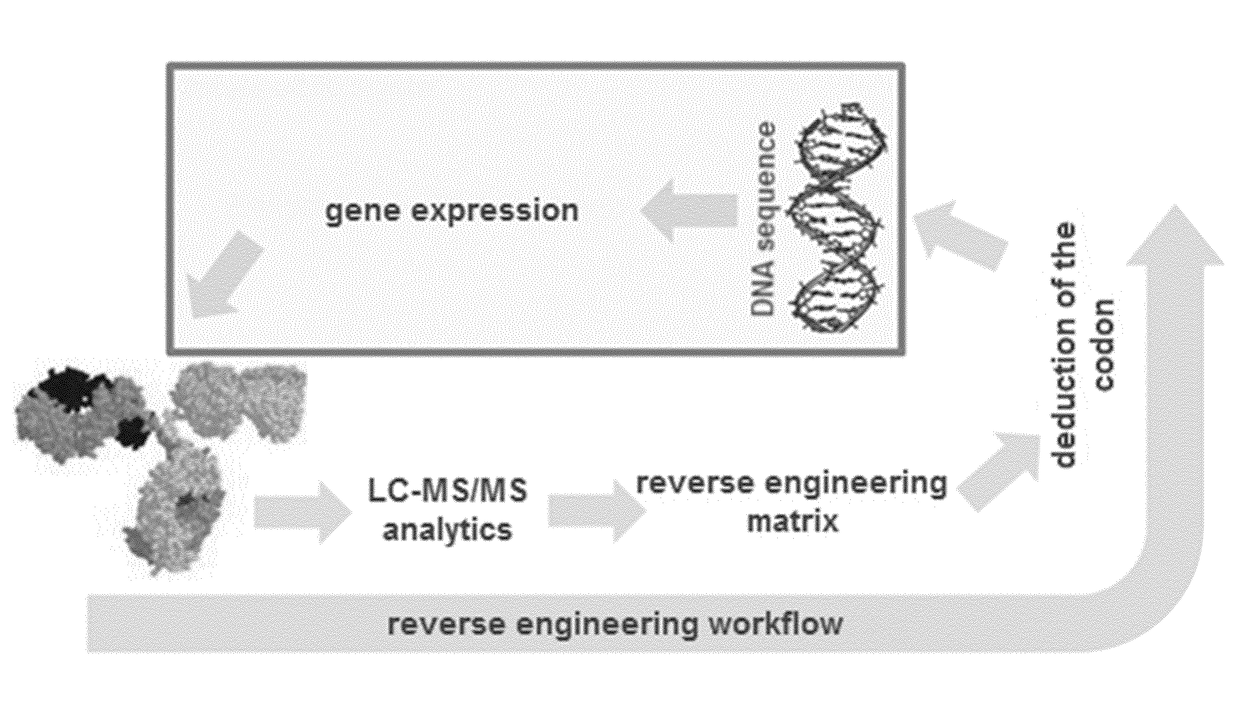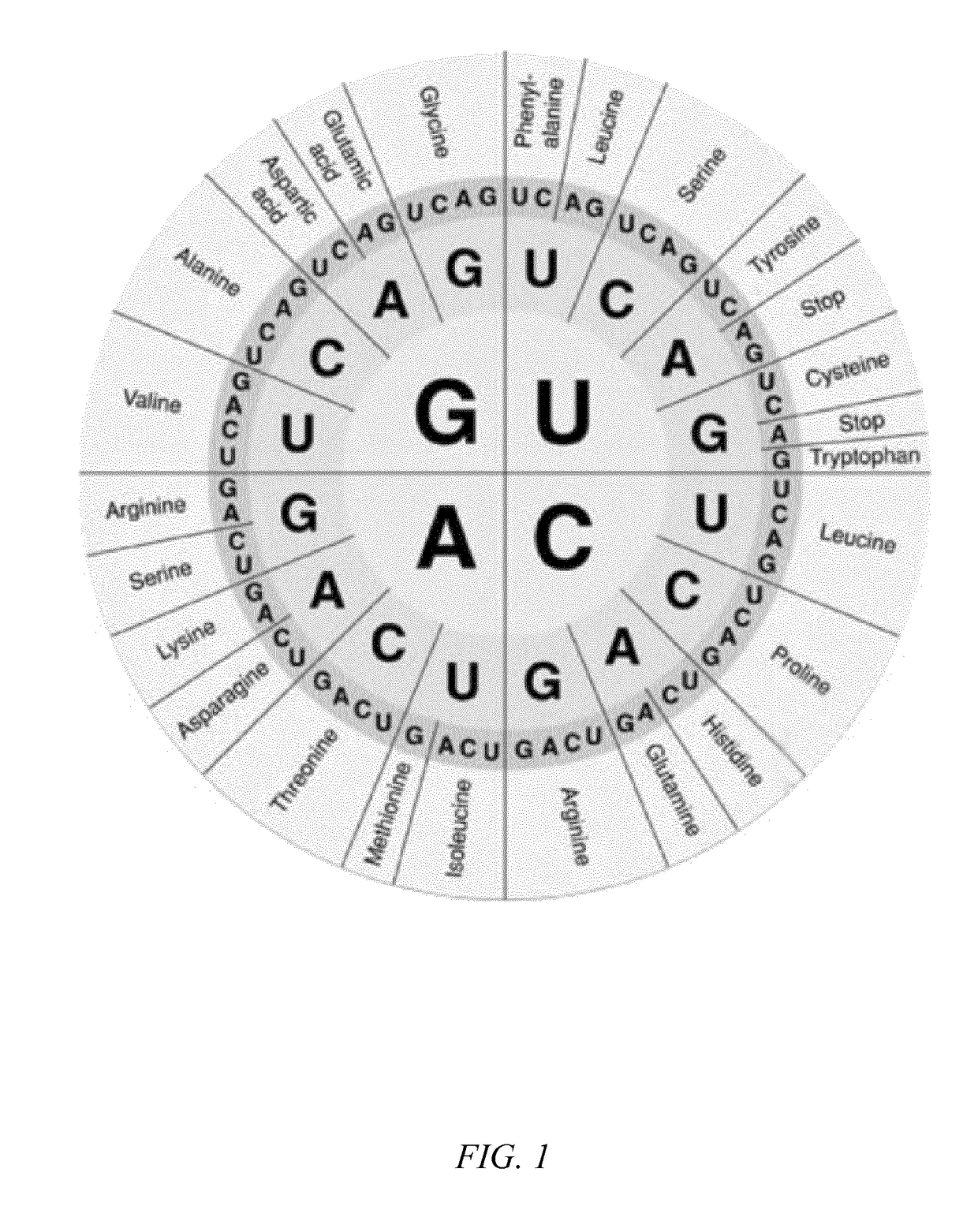Sequence Variants
a polynucleotide and coding sequence technology, applied in the field of sequence variants, can solve the problems of increased purification effort, reduced immunogenicity, and reduced quality, and achieve the effect of improving immunogenicity, improving quality, and improving coding sequences
- Summary
- Abstract
- Description
- Claims
- Application Information
AI Technical Summary
Benefits of technology
Problems solved by technology
Method used
Image
Examples
example 1
Sequence Variants
[0091]LC-MS / MS analysis of a given polypeptide according to standard practice reveals the native peptide STSGGTAALGCLVK and three low-level sequence variants. At the three Gly positions of the native peptide, sequence variants each comprising a Gly to Glu (G→E), or a Gly to Asp (G→D) amino acid misincorporation are identified at a relative abundancy of about 0.02% of the total amount of peptide), as shown in Table 4.
TABLE 4RelativesequenceabundancyNative peptideSTSGGTAALGCLVK~99.94%Sequence variant 1STSEGTAALGCLVK ~0.02%Sequence variant 2STSGDTAALGCLVK ~0.02%Sequence variant 3STSGGTAALDCLVK ~0.02%
[0092]Sequence variant 1 comprises a Glu residue instead of Gly residue at amino acid position 4, as highlighted in Table 4. A Glu residue being misincoporated instead of Gly can be explained either by a C*A mismatch during transcription or a G*U mismatch during translation, as shown in FIG. 2A. Both mismatches lead to a base difference of G for A in the genetic code. Accor...
example 2
ngineering
[0097]The polypeptide obtainable by expression from the polynucleotide to be optimized by reverse-engineering is digested in silico, e.g., by trypsin. Amino acid residues Gly, Ser, Arg, Val, Ile, Leu and Met are replaced by their respective sequence variants in accordance with the reverse engineering matrix as disclosed in Table 3, and are tested for their presence in the acquired MS data, preferably using an extracted ion chromatogram (EIC). If a particular type of amino acid residue is present more than once within a peptide, its position must be determined using an MS / MS experiment, as exemplary shown in FIG. 5.
[0098]The exemplary peptide VVSVLTVLHQDWLNGK contains amino acid residues Gly, Ser and Val, which can be used for the method of the invention for reverse engineering at least one codon of the polynucleotide encoding the peptide. FIG. 5 shows the analysis of the amino acid residue misincorporations Val to Met (V→M) and Val to Ile (V→I). In accordance with the reve...
example 3
imization to Reduce the Immunogenic Potential (CORIP)
[0105]Gly can be encoded by GGA, GGG, GGC and GGU, or the DNA counterpart, respectively, see Table 2. According to Table 2 above, the following amino acid misincorporations can occur:[0106]a. Gly→Asp or Gly→Ser (Codons: GGC or GGU); or[0107]b. Gly→Glu or Gly→Arg (Codon: GGG or GGA).
[0108]To decide which codon should be selected to encode glycine at the individual positions in order to decrease the immunogenic potential of the corresponding polypeptide, each Gly residue is individually substituted in silico by each of the aforementioned four potentially misincorporated amino acid residues. For example, in a given polypeptide sequence containing ten glycine residues, a total of 50 hypothetical protein sequences will be generated; 10 for the native protein and 10 each where one Gly residue in the sequence is substituted by Asp, Ser, Glu or Arg.
[0109]Next, the obtained protein sequences are subjected to an in silico prediction of T he...
PUM
| Property | Measurement | Unit |
|---|---|---|
| inner diameter | aaaaa | aaaaa |
| mass spectrometry | aaaaa | aaaaa |
| HPLC- | aaaaa | aaaaa |
Abstract
Description
Claims
Application Information
 Login to View More
Login to View More - R&D
- Intellectual Property
- Life Sciences
- Materials
- Tech Scout
- Unparalleled Data Quality
- Higher Quality Content
- 60% Fewer Hallucinations
Browse by: Latest US Patents, China's latest patents, Technical Efficacy Thesaurus, Application Domain, Technology Topic, Popular Technical Reports.
© 2025 PatSnap. All rights reserved.Legal|Privacy policy|Modern Slavery Act Transparency Statement|Sitemap|About US| Contact US: help@patsnap.com



